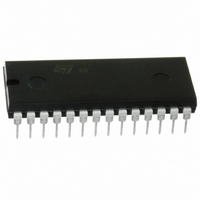TDA7318 STMicroelectronics, TDA7318 Datasheet - Page 8

TDA7318
Manufacturer Part Number
TDA7318
Description
IC PROCESSOR STEREO DGTL 28-DIP
Manufacturer
STMicroelectronics
Type
Audio Processorr
Datasheet
1.TDA7318.pdf
(14 pages)
Specifications of TDA7318
Applications
Hi-Fi Systems
Mounting Type
Through Hole
Package / Case
28-DIP (0.600", 15.24mm)
Lead Free Status / RoHS Status
Lead free / RoHS Compliant
Available stocks
Company
Part Number
Manufacturer
Quantity
Price
Company:
Part Number:
TDA7318D
Manufacturer:
ST
Quantity:
5 510
Part Number:
TDA7318D
Manufacturer:
ST
Quantity:
20 000
Part Number:
TDA7318D013TR
Manufacturer:
ST
Quantity:
20 000
TDA7318
I
Data transmission from microprocessor to the
TDA7318 and viceversa takes place thru the 2
wires I
lines SDA and SCL (pull-up resistors to positive
supply voltage must be connected).
Data Validity
As shown in fig. 14, the data on the SDA line
must be stable during the high period of the clock.
The HIGH and LOW state of the data line can
only change when the clock signal on the SCL
line is LOW.
Start and Stop Conditions
As shown in fig.15 a start condition is a HIGH to
LOW transition of the SDA line while SCL is
HIGH. The stop condition is a LOW to HIGH tran-
sition of the SDA line while SCL is HIGH.
Byte Format
Every byte transferred on the SDA line must con-
tain 8 bits. Each byte must be followed by an ac-
Figure 14: Data Validity on the I
Figure 15: Timing Diagram of I
Figure 16: Acknowledge on the I
8/14
2
C BUS INTERFACE
2
C BUS interface, consisting of the two
2
CBUS
2
2
CBUS
CBUS
knowledge bit. The MSB is transferred first.
Acknowledge
The master ( P) puts a resistive HIGH level on the
SDA line during the acknowledge clock pulse (see
fig. 16). The peripheral (audioprocessor) that ac-
knowledges has to pull-down (LOW) the SDA line
during the acknowledge clock pulse, so that the
SDA line is stable LOW during this clock pulse.
The audioprocessor which has been addressed
has to generate an acknowledge after the recep-
tion of each byte, otherwise the SDA line remains
at the HIGH level during the ninth clock pulse
time. In this case the master transmitter can gen-
erate the STOP information in order to abort the
transfer.
Transmission without Acknowledge
Avoiding to detect the acknowledge of the audio-
processor, the P can use a simplier transmis-
sion: simply it waits one clock without checking
the slave acknowledging, and sends the new
data.
This approach of course is less protected from
misworking and decreases the noise immunity.













